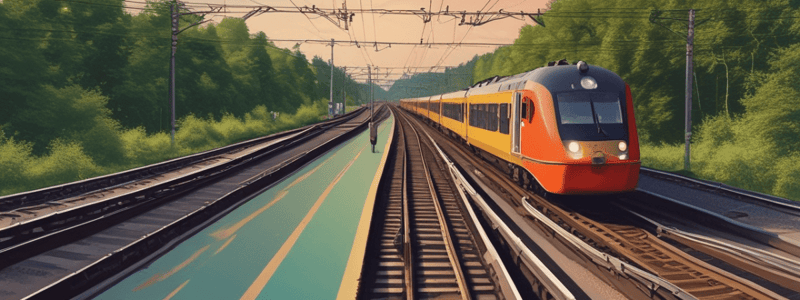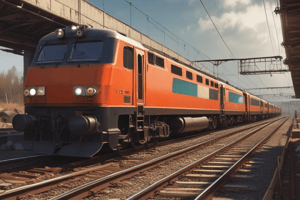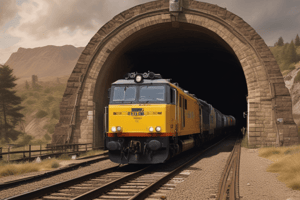Podcast
Questions and Answers
What is the peak vertical acceleration for unevenness in a track?
What is the peak vertical acceleration for unevenness in a track?
- 0.25 g
- 0.20 g (correct)
- 0.22 g
- 0.18 g
What is the SD limit for UN-1 unevenness?
What is the SD limit for UN-1 unevenness?
- 2.9 mm (correct)
- 3.4 mm
- 4.4 mm
- 5.1 mm
What is the peak limit for AL-1 alignment?
What is the peak limit for AL-1 alignment?
- 12 mm
- 11 mm
- 13 mm (correct)
- 10 mm
What is the mean gauge limit over 200m for a curve with radius 440m or more?
What is the mean gauge limit over 200m for a curve with radius 440m or more?
What is the isolated defect limit for nominal track gauge to peak value in a curve with radius less than 440m?
What is the isolated defect limit for nominal track gauge to peak value in a curve with radius less than 440m?
What is the limit for twist (TW-1) in a track?
What is the limit for twist (TW-1) in a track?
What is the urgent maintenance limit for unevenness?
What is the urgent maintenance limit for unevenness?
What is the need-based maintenance limit for alignment?
What is the need-based maintenance limit for alignment?
What is the primary purpose of Track Recording Cars?
What is the primary purpose of Track Recording Cars?
Which of the following is not used to measure track geometry parameters in Track Recording Cars?
Which of the following is not used to measure track geometry parameters in Track Recording Cars?
What is the principle of measurement used by Track Recording Cars to measure track geometry parameters except Gauge?
What is the principle of measurement used by Track Recording Cars to measure track geometry parameters except Gauge?
What is the purpose of gyroscopes in Track Recording Cars?
What is the purpose of gyroscopes in Track Recording Cars?
What is measured by accelerometers in Track Recording Cars?
What is measured by accelerometers in Track Recording Cars?
What is the output of the acceleration values obtained from accelerometers in Track Recording Cars?
What is the output of the acceleration values obtained from accelerometers in Track Recording Cars?
Which of the following is used to obtain relative displacement between rail and accelerometer locations in Track Recording Cars?
Which of the following is used to obtain relative displacement between rail and accelerometer locations in Track Recording Cars?
What is the limit for Unevenness (UN-1) under Planned Maintenance?
What is the limit for Unevenness (UN-1) under Planned Maintenance?
What is the purpose of combining the loci of accelerometers with relative displacement between accelerometers and rail in Track Recording Cars?
What is the purpose of combining the loci of accelerometers with relative displacement between accelerometers and rail in Track Recording Cars?
What is the limit for Alignment (AL-1) under Urgent Maintenance?
What is the limit for Alignment (AL-1) under Urgent Maintenance?
What is the limit for Gauge (Mean gauge over 200 m section) in a Curve with radius less than 440 m?
What is the limit for Gauge (Mean gauge over 200 m section) in a Curve with radius less than 440 m?
What is the limit for Twist (TW-1) under Urgent Maintenance?
What is the limit for Twist (TW-1) under Urgent Maintenance?
What is the limit for Unevenness (UN-2) under Urgent Maintenance?
What is the limit for Unevenness (UN-2) under Urgent Maintenance?
What is the limit for Alignment (AL-2) under Planned Maintenance?
What is the limit for Alignment (AL-2) under Planned Maintenance?
What is the limit for Gauge (Isolated defects) in a Straight section?
What is the limit for Gauge (Isolated defects) in a Straight section?
What is the vertical and lateral acceleration peak for Alignment (AL-2)?
What is the vertical and lateral acceleration peak for Alignment (AL-2)?
What is the purpose of the TQI-C index?
What is the purpose of the TQI-C index?
What is the unit of measurement for the gauge parameter?
What is the unit of measurement for the gauge parameter?
What is the purpose of the MI-SD based on PML and NBML?
What is the purpose of the MI-SD based on PML and NBML?
What is the purpose of reporting the 10 highest peak values of alignment and unevenness parameters?
What is the purpose of reporting the 10 highest peak values of alignment and unevenness parameters?
What is the purpose of the UNI-1 and UNI-2 indices?
What is the purpose of the UNI-1 and UNI-2 indices?
What is the purpose of the ALI-1 and ALI-2 indices?
What is the purpose of the ALI-1 and ALI-2 indices?
What is the purpose of reporting the total number of peaks above NBML and UML for twist?
What is the purpose of reporting the total number of peaks above NBML and UML for twist?
What is the purpose of the vertical and lateral ride index on coach floor above bogie pivot?
What is the purpose of the vertical and lateral ride index on coach floor above bogie pivot?
What is the vertical acceleration peak limit for unevenness in a track for speeds above 110 kmph and up to 130 kmph?
What is the vertical acceleration peak limit for unevenness in a track for speeds above 110 kmph and up to 130 kmph?
For a curve with a radius less than 440m, what is the need-based maintenance limit for gauge?
For a curve with a radius less than 440m, what is the need-based maintenance limit for gauge?
What is the planned maintenance limit for unevenness UN-2?
What is the planned maintenance limit for unevenness UN-2?
For a curve with a radius of 440m or more, what is the urgent maintenance limit for gauge?
For a curve with a radius of 440m or more, what is the urgent maintenance limit for gauge?
What is the planned maintenance limit for alignment AL-1?
What is the planned maintenance limit for alignment AL-1?
For a track section, what is the need-based maintenance limit for gauge in a straight section?
For a track section, what is the need-based maintenance limit for gauge in a straight section?
What is the urgent maintenance limit for twist (TW-1) in a track?
What is the urgent maintenance limit for twist (TW-1) in a track?
For speeds above 110 kmph and up to 130 kmph, what is the need-based maintenance limit for alignment AL-2?
For speeds above 110 kmph and up to 130 kmph, what is the need-based maintenance limit for alignment AL-2?
Flashcards are hidden until you start studying
Study Notes
Track Monitoring and Tolerances
- Track monitoring is essential for assessing track quality and identifying defects.
- The following mechanized means are used on Indian Railways for objective assessment of track quality:
- Track Recording Car
- Oscillation Monitoring System
- Oscillograph Car
Track Recording Cars
- Track Recording Cars (TRCs) collect discrete values of various track geometry parameters on selected sampling intervals under loaded conditions.
- TRCs work on the inertial principle of measurements, using accelerometers to measure lateral and vertical accelerations.
- The acceleration values are integrated twice to get the loci of the location of accelerometers.
- The relative displacements between rail and accelerometer locations are obtained from displacement transducers (LVDT) or LASER-based contactless sensors.
- The loci of accelerometers are combined with relative displacement between accelerometers and rail to derive the vertical and lateral profile of the rail.
Track Quality Index (TQI)
- Track Quality Index (TQI) is calculated for both short and long chords (TQI-S and TQI-L).
- Composite Track Quality Index (TQI-C) is calculated for sections with speeds > 100 kmph.
- Maintenance Instructions corresponding to SD (MI-SD) are based on PML and NBML for Unevenness and Alignment.
Results Reported
- Results are reported for the whole kilometer.
- The report includes:
- Total number of peaks above Need Based Maintenance Limits (NBML) and Urgent Maintenance Limit (UML) for various parameters.
- Parameter Indices for Unevenness (UNI-1 & UNI-2) and Alignment (ALI-1 & ALI-2) on short and long chords.
- Average speed.
- Vertical and Lateral Ride Index on coach floor above bogie pivot (at accelerometer location).
- 10 highest peak values of alignment and unevenness parameters with location on long and short chords.
Maintenance Limits
- Planned Maintenance Limit (PML) and Need Based Maintenance Limit (NBML) are specified for various parameters:
- Unevenness (UN-1 & UN-2)
- Alignment (AL-1 & AL-2)
- Gauge (mean gauge over 200 m section and isolated defects)
- Twist (TW-1)
- Urgent Maintenance Limit (UML) is specified for vertical and lateral acceleration.
Speed-Based Maintenance Limits
- Maintenance limits vary based on speed:
- For speeds above 100 kmph and up to 110 kmph:
- Planned Maintenance Limit (PML) and Need Based Maintenance Limit (NBML) for various parameters.
- For speeds above 110 kmph and up to 130 kmph:
- Planned Maintenance Limit (PML) and Need Based Maintenance Limit (NBML) for various parameters.
- For speeds above 130 kmph and up to 160 kmph:
- Planned Maintenance Limit (PML) and Need Based Maintenance Limit (NBML) for various parameters.
- For speeds above 100 kmph and up to 110 kmph:
Studying That Suits You
Use AI to generate personalized quizzes and flashcards to suit your learning preferences.




